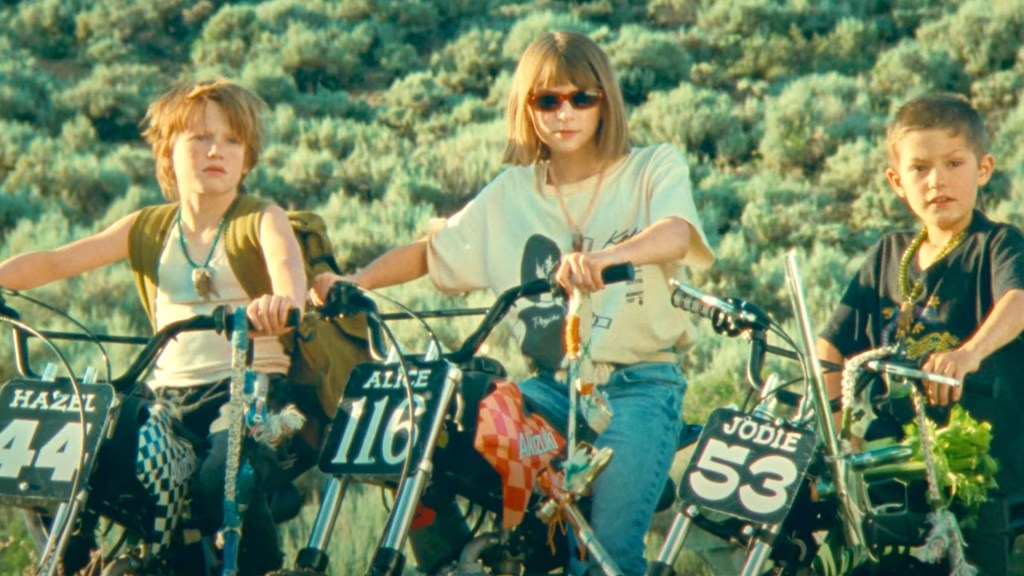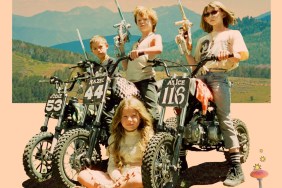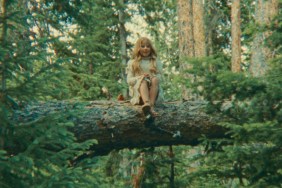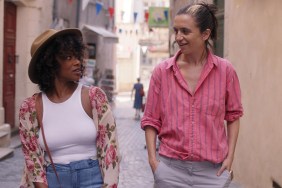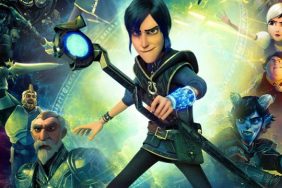Weston Razooli evokes the spirit of classic kid adventures but sharpens the edges with his debut feature film, Riddle of Fire.
Dubbed a ”Neo-Fairytale”, Riddle of Fire sees three mischievous children living in a fairly rural area with dreams of spending the day playing video games. But the mother of two of the children is feeling quite ill, and wants them to complete a simple task before they can do so: fetch a blueberry pie from the bakery in town.
But this menial job takes on a life of its own, and the kid’s journey becomes an odyssey involving poachers, fairies, and a great spirit of the forest.
Some of the above is true, the rest is very much how the kids interpret things. These are kids who are not exactly innocent, but holding onto what’s left of it. The film’s lo-fi fusion of folklore-driven adventure and grounded childhood shenanigans does a fine job of capturing the blend of children’s excitable imagination and their discovery of the world’s nasty side.
Riddle of Fire is instantly striking thanks to being shot on 16mm. The seemingly endless fields and forests that these characters inhabit feel epic in scope, something bigger than the story it contains, and perfect for a low-stakes quest made to feel gargantuan.
The aura of Riddle of Fire almost gives off a hazy summer heat reminiscent of my own childhood adventures roaming through woodland and parks—the inescapable feeling of being in another world even though I knew I was fairly close to home.
The three kids central to this story play their roles naturalistically. It can come off a tad sloppy when they stumble and fluff lines, but it’s clearly a deliberate choice to make them feel less like actors and more like y’know…kids.

They have their own group logic and rules that come across as something engrained over the years rather than the span of a film shoot. I felt very much like an observer in their world at a fleeting glance rather than being told their life story to that point.
Charlie Stover and Skyler Peters play brothers Hazel and Jodie A’Dale, while Phoebe Ferro plays their friend and neighbor Alice. There’s a shy, awkward love story cooking underneath the adventure for Hazel and Alice that grows into an important part of their personal stories, but it’s Peters’ Jodie that steals the show with the funniest lines and actions.
Sounding like an adult who’s walked in from another film in the wrong body, Jodie is hard-subtitled the whole way and is probably the character that best showcases the kind of genre and style weaving tone Razooli is going for. Strange, endearing, and dipping his toes into fantasy and reality at whim.
I really like the absurdity that the central quest of the film isn’t about kids seeking lost treasures, defeating an ancient evil, or even just finding a dead body. It’s literally about getting hold of a blueberry pie in the middle of nowhere so they can play video games for a couple of hours. Yet Razooli and his cast make it feel like so much more. The personal journies for the younger characters are formulaic in their basic structure (which does help the film lean into its nostalgia-baiting wide-eyed wonder) but engulfed in the world Razooli has created, they feel bigger.
It helps that the adult characters tend to have the kind of edge to them that is less Mama Fratelli and more Henry Bowers without pushing things down too dark a path. The poachers are given an introduction that emphasizes this as the head of their cult-like family, Anna-Freya Hollyhock (played by Crazy Stupid Love and Warm Bodies star Lio Tipton), demonstrates her otherworldly menace without a hint of actual magic or gore.
What’s interesting is that she and her bumbling poacher crew are viewed as viable threats and horrible people in the eyes of Hazel, Jodie, and Alice, but Anna-Freya’s daughter Petal is portrayed not as a child of a broken and messed up family, but as a defiant, loving free spirit who wants nothing more than to be best friends with The A’Dale brothers and Alice. There’s no redeeming arc for Anna-Freya, which would have been the easiest thing to do with a character like Petal, and I applaud Razooli for not adding saccharine where it wasn’t needed.
But as sharp-edged and foul-mouthed as Riddle of Fire can be, it still invests heavily in that saccharine when necessary. The fairytale undertone gives the film license to wrap some things up in a pretty bow even when the world at large has already shown how ugly it is, but in that sense, it’s a fine compromise between how fairytales were told and how they tend to be told now. Grit and glitter in the same pot.
I’m a fan of Weston Razooli’s debut. Does it crib from nostalgic sources to help create its look and tone? Sure, but like any well-worn toll of filmmaking, it’s all about the application of these factors that matters, not the freshness of them. It probably runs a little too long for the good of its finale, though, and almost ends up in danger of dousing its magical fire with a bucket of sand.
As a whole though, Riddle of Fire is a dark, yet whimsical, adventure movie with a wonderfully understated off-kilter tone. It’s an impressive debut with a confident idea of what it wants to be.
Score: 8/10
As ComingSoon’s review policy explains, a score of 8 equates to ”Great”. While there are a few minor issues, this score means that the art succeeds at its goal and leaves a memorable impact.
Riddle of Fire is in theaters on March 22, 2024.
Riddle of Fire screener provided for review.
